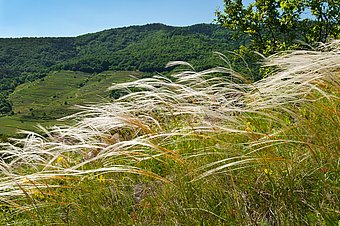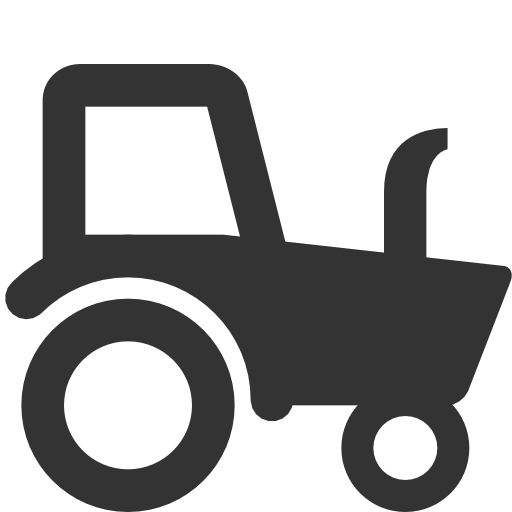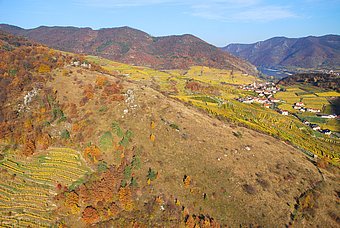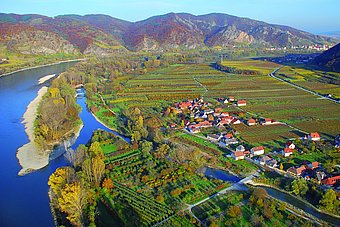Natural areas and cultural landscapes
It is the combination of river landscape, dry grasslands, slopes, near-natural forests, wine terraces and orchards that defines the Wachau’s importance as a nature conservation area. The special variety of geology, climate and landscape is reflected in a biodiverse flora and fauna. The different habitats provide refuge for 30 types of orchid, such as the lady’s slipper and Adriatic lizard orchid. Rare bird species, such as the peregrine falcon, black stork, eagle-owl, common kingfisher and hoopoe can be observed, while bee-eaters and white-tailed eagles are regular guests. Juvenile fish can survive in the side arms and shallow water zones of the Danube protected from the breaking of waves. Over 50 species of fish – such as Danube salmon and common nase – as well as beaver and otter can be found.
In the spring, blossoms adorn the Wachau with a riotous, constantly changing coat of colour. The apricot blossom in mid-April is considered to be the highlight of the season. European ground squirrel, European mantis and predatory bush cricket live in the meadows and the heraldic animal of the Wachau – the European green lizard – feels particularly at home in the traditional and ecologically valuable dry stone walls.
The Danube
The free-flowing Danube in the Wachau is noted for numerous gravel islands, gravel banks, old courses and the remains of riparian forests. The ecological gravel structures and the renatured arms of the Danube in Schallemmersdorf-Grimsing, Schönbühel, Aggsbach Dorf and Rossatz-Rührsdorf support the rich variety of fish in the Wachau. Extensive riparian forests can be found in Melk, Emmersdorf, Schönbühel and Rossatz. Of particular note are the softwood riparian forests – which are endangered across Europe – with white willow and black poplar, as the riparian forests were often planted with non-native hybrid poplar or eastern black walnut plantations in recent times. The remains of near-natural wetlands can still be found at Melk, on Schönbüheler Island as well as near Rossatz, Joching and Mautern. Old, near-natural stocks of riparian forest are home to over 50 types of bird, rare bats and bark beetles, such as the cinnabar flat bark beetle.
The dry grasslands and meadows

Biodiverse dry grasslands can be found in Spitz, St. Michael, Dürnstein-Loiben, Rossatz and Krems. They are home to a varied world of flora and fauna. The Höhereck near Dürnstein is the biggest dry grassland in the eastern Wachau with 200 different species of plant and approx. 100 species of butterfly. Typical of the Wachau’s dry grasslands are the feather grass (Steinfeder) and the Large and the Black pasque flower. On the plateau of the Jauerling and in its side-valleys, the remains of traditional, sparse orchid meadows still exist.
Maintaining and managing the dry grasslands, semi-dry grasslands and poor grasslands is a big challenge for conservation managers. Since 2010, large parts of the valuable meadowlands have been managed within the scope of projects run by volunteers.
The natural forests
In the Wachau, a distinction is made between oak woods on acid soil, oak-hornbeam forests, Scots pine forests and beech woods, depending on the location. A special feature, endangered across Europe, are south-facing, light downy oak forests, which are found only in a few places, such as at the Teufelsmauer in Spitz. These near-natural forest habitats offer mammals, bats and many types of bird and insect somewhere to live. Black stork, European honey buzzard, middle-spotted woodpecker, stock dove and red-breasted flycatcher can be found in the natural forests. A seldom-seen sight in primeval-seeming old-growth forests, e.g. in the Steinige Ries near Rossatz, is the rare white-backed woodpecker. The replacement of natural deciduous forests with monotonous ranks of Douglas firs and spruce signifies a bitter loss for the ecological diversity in the World Heritage Site.




